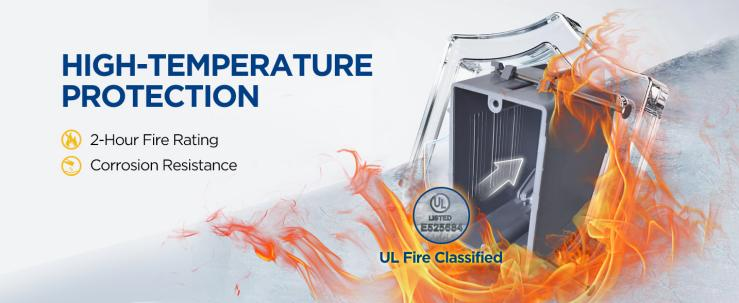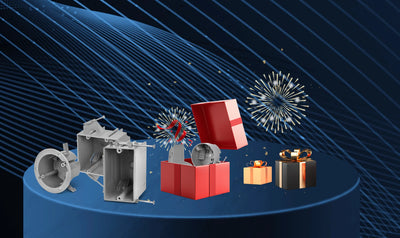Junction boxes are essential for electrical organization and safety. However, poor installation can result in short circuits, fire risks, and other electrical hazards. A safe and effective electrical system depends on avoiding common installation errors. This guide will help you install a junction box correctly by highlighting the most common mistakes and offering helpful advice.
Table of Contents
1.Common Mistakes to Avoid When Installing a Junction Box
2.What is a Junction Box and Why is Proper Installation Important?
3.Mistake #1: Choosing the Wrong Type of Junction Box
4.Mistake #2: Incorrect Box Placement
5.Mistake #3: Overcrowding Wires in the Box
6.Mistake #4: Poor Grounding and Bonding
7.Mistake #5: Ignoring Local Electrical Codes
8.Mistake #6: Using Damaged or Low-Quality Materials
9.Conclusion: Tips for a Safe and Successful Installation
Common Mistakes to Avoid When Installing a Junction Box

Installing a junction box may seem like a simple task, but even small mistakes can lead to serious safety hazards, code violations, or costly repairs. Whether you’re a DIY enthusiast or a professional electrician, avoiding these common errors is crucial for a safe and successful installation. In this article, we’ll walk you through the most frequent mistakes and how to avoid them.
What is a Junction Box and Why is Proper Installation Important?

A junction box is an enclosure that protects electrical connections from external damage, moisture, and accidental contact. Proper installation ensures:
l Safe containment of electrical connections
l Prevention of overheating and electrical fires
l Compliance with building and safety code
l Longevity and efficiency of the electrical system
Tips:Togalonn’s junction boxes are designed for safety and durability.Failing to install a junction box correctly can result in severe safety hazards and costly repairs.
Mistake #1: Choosing the Wrong Type of Junction Box

Different environments and electrical requirements demand different types of junction boxes. Selecting the wrong type can compromise safety and functionality.
Common Errors:
l Using a plastic junction box in an industrial or high-heat setting
l Installing a non-weatherproof box outdoors
l Choosing a box that is too small for the number of wires
How to Avoid This Mistake:
l Indoor vs Outdoor: Use weatherproof boxes for outdoor or damp locations.
l Fire Safety: Choose fire-rated boxes for commercial or industrial settings.
l Load Capacity: Ensure the box can handle the number and size of wires.
Tips:For outdoor installations, weatherproof junction boxes are a must.
Mistake #2: Incorrect Box Placement

Placing the junction box in the wrong location can make it inaccessible or unsafe. For example, installing it too close to flammable materials or in hard-to-reach areas can create hazards.
How to Avoid This Mistake:
l Always install junction boxes in accessible locations.
l Keep them away from plumbing and flammable materials.
l Follow NEC regulations for proper height and clearance.
Mistake #3: Overcrowding Wires in the Box

Overfilling a junction box with too many wires can cause overheating, short circuits, or even fires. Each box has a specific fill capacity, which must not be exceeded.
How to Avoid This Mistake:
l Choose a junction box with enough volume to accommodate all wires comfortably.
l Use the NEC wire capacity chart to calculate the correct box size.
l Use wire nuts or push-in connectors for safe connections.
Tips:Check out Togalonn’s spacious junction boxes for complex wiring setups.
Mistake #4: Poor Grounding and Bonding
Improper grounding can lead to electrical shocks or equipment damage. A junction box must be properly grounded to ensure safety.
How to Avoid This Mistake:
l Connect the ground wire securely to the box and all devices.
l Use grounding screws or clips as required.
l Test the grounding with a multimeter to ensure proper connection.
Mistake #5: Ignoring Local Electrical Codes
Common Errors:
l Using outdated or non-compliant materials
l Installing junction boxes in unapproved locations
l Failing to get necessary permits or inspections
How to Avoid This Mistake:
l Familiarize yourself with the NEC and local regulations.
l Use code-compliant materials and installation methods.
l Consult a licensed electrician if unsure about code requirements.
Tips:Learn more about NEC compliance for junction boxes.
Mistake #6: Using Damaged or Low-Quality Materials

Using damaged or substandard junction boxes can compromise the safety and longevity of your electrical system.
How to Avoid This Mistake:
l Inspect the box for cracks, dents, or defects before installation.
l Choose high-quality boxes from trusted brands like Togalonn.
l Avoid cutting corners to save money; prioritize safety and durability.
Conclusion: Tips for a Safe and Successful Installation
Installing a junction box correctly is essential for the safety and efficiency of your electrical system. By avoiding these common mistakes—choosing the wrong box, incorrect placement, overcrowding wires, poor grounding, ignoring codes, and using low-quality materials—you can ensure a safe and code-compliant installation.
To ensure a safe and effective junction box installation, follow these best practices:
l Select the right type and size of junction box for the application.
l Install it in an accessible and safe location.
l Avoid overcrowding wires inside the box.
l Properly ground and bond all electrical connections.
l Follow local electrical codes and safety regulations.
l Use high-quality materials to ensure durability and performance.

At Togalonn, we offer a wide range of durable and code-compliant junction boxes designed for every application. Explore our collection today and make your next installation a success!

FAQs:
1. Why is proper junction box installation important?
Proper installation helps protect wire connections, preventing short circuits, fires, and other electrical hazards.
2. How do I choose the right junction box?
When selecting a junction box, consider the installation environment (indoor or outdoor), material (plastic or metal), size.
3. What should I consider when placing a junction box?
Avoid placing it in hidden areas or hard-to-reach walls.
4. Why shouldn’t a junction box be overcrowded with wires?
Overcrowding wires can lead to overheating, increased short circuit risks, and poor connections.
5. What should I know about grounding and wiring a junction box?
Make sure metal junction boxes are properly grounded, and all wire connections are secure. Avoid exposed copper wire touching metal surfaces to prevent electrical shocks or short circuits.
6. How can I ensure compliance with local electrical codes when installing a junction box?
Check local building and electrical codes (such as NEC, IEC, etc.) before installation, or consult a professional electrician to ensure all steps meet safety requirements.
7. Why shouldn’t I use low-quality or damaged junction boxes?
Using poor-quality or damaged junction boxes can lead to exposed wires, loose connections, and even fire hazards. Always choose high-quality junction boxes from reputable brands for long-term safety.

